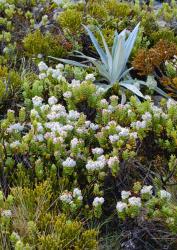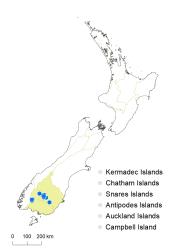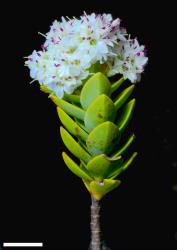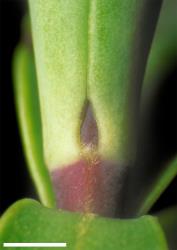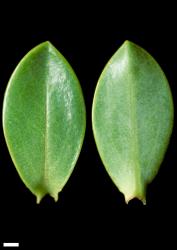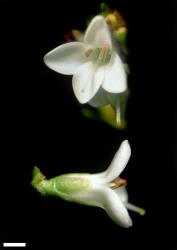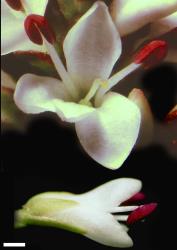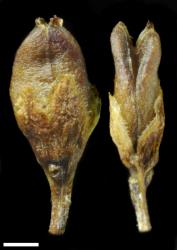- ≡ Hebe dilatata G.Simpson & J.S.Thomson, Trans. & Proc. Roy. Soc. New Zealand 73: 164 (1943)
- = Hebe crawii Heads, Bot. Soc. Otago Newsl. 5: 11 (1987)
Spreading low shrub to 0.4 m tall. Stems decumbent or ascending, eglandular-pubescent; hairs bifarious. Leaf bud distinct, its leaves appressed at margins until fully grown; sinus acute. Leaves opposite-decussate to sub-distichous, erecto-patent to recurved; lamina coriaceous, obovate to spathulate to elliptic, 4–25 mm long, 4–11 mm wide, dull or somewhat glossy pale green or glaucescent above and beneath; midrib evident and two lateral veins sometimes faintly visible; surfaces glabrous or eglandular-hairy along midrib above; margin glabrous or minutely papillate, entire; apex obtuse to rounded, sometimes weakly plicate-emarginate; base abruptly cuneate; petiole 0.5–4.0 mm long. Inflorescence a lateral spike or raceme, tripartite or simple, 5–42 mm long; flowers crowded, 5–52, female or bisexual on separate plants, ⚥ > ♀; bracts opposite below and the lowermost usually flowerless, becoming alternate above, narrowly deltoid to lanceolate to elliptic to ovate, > pedicels; pedicels erecto-patent, 0.5–3.0 mm long, eglandular-hairy all around and sometimes also with short glandular hairs. Calyx lobes 4 or posterior small 5th lobe sometimes present, anterior pair fused ⅓ to completely, sub-acute to obtuse, 2.0–2.7 mm long, unequal, mixed glandular- and eglandular-ciliolate. Corolla 5–10 mm diameter; tube white, 1.2–2.5 mm long, ≤ calyx, glabrous; lobes 4, white, sub-erect to spreading, unequal, elliptic or oblong to ovate, 2.0–4.5 mm long, obtuse to rounded; nectar guides absent. Stamen filaments white, 3.8–4.5 mm long (1.0–2.5 mm in staminodes); anthers magenta (pale in staminodes). Style glabrous, 3.4–7.0 mm long. Capsules latiseptate, sub-acute to obtuse, glabrous, 3.4–4.5 mm long, 2.1–2.8 mm wide. Seeds ovoid to subdiscoid, flattened, smooth, straw-yellow to pale brown, 0.9–1.1 mm long.
In Fiordland, west of the range of V. dilatata, two species, V. cockayneana and V. arganthera, have similar dull or glaucous leaves and a narrow, acute leaf bud sinus. In V. cockayneana the leaves are discolorous, glossy green above and dull glaucescent beneath; the plants tend to grow more erect but may be low-growing in exposed sites. V. arganthera plants are often larger (up to 1.5 m tall); that species is distinguished from V. dilatata by longer leaves (12–38 mm long, 5–11 mm wide), ciliate or ciliolate leaf margins, and white anthers. V. cockayneana plants have the same chromosome number as V. dilatata (2n = 120), whereas V. arganthera have 2n = 40.
South Island: South Otago and Southland (Eyre Mountains, Garvie Mountains, Umbrella Mountains, Takitimu Mountains).
An early record from the Blue Mountains has not been supported by recent collecting.
Alpine tussock grassland, especially in rocky sites, rock outcrops, screes. Recorded elevations range from 823 to 1600 m.
Flowers: November–January, sometimes to March); fruits: November–March, persisting longer.
2n = 120 (see Bayly & Kellow 2006, as Hebe dilatata).
Veronica dilatata is classified in V. subg. Pseudoveronica sect. Hebe and the informal group “Apertae” (small-leaved) (Albach & Meudt 2010; Bayly & Kellow 2006). Limited molecular studies have not provided strong evidence of close relationships of V. dilatata. Morphology and chromosome numbers suggest V. cockayneana might be a close relative, and beyond that it might be related to V. arganthera and to several similar species from Nelson (V. baylyi, V. rigidula, V. cryptomorpha, V. simulans).
Plants from the Takitimu Mountains tend to have pedicels > calyx, and they more often have some glandular hairs, than plants from the Garvie, Umbrella, and Eyre Mountains, which have pedicels ≤ calyx. They also have more tripartite inflorescences and their leaves are more glaucescent. These have been separated taxonomically (as Hebe crawii), but consistent and qualitative differences that would indicate the existence of genetically separate and differentiated lineages are lacking.



